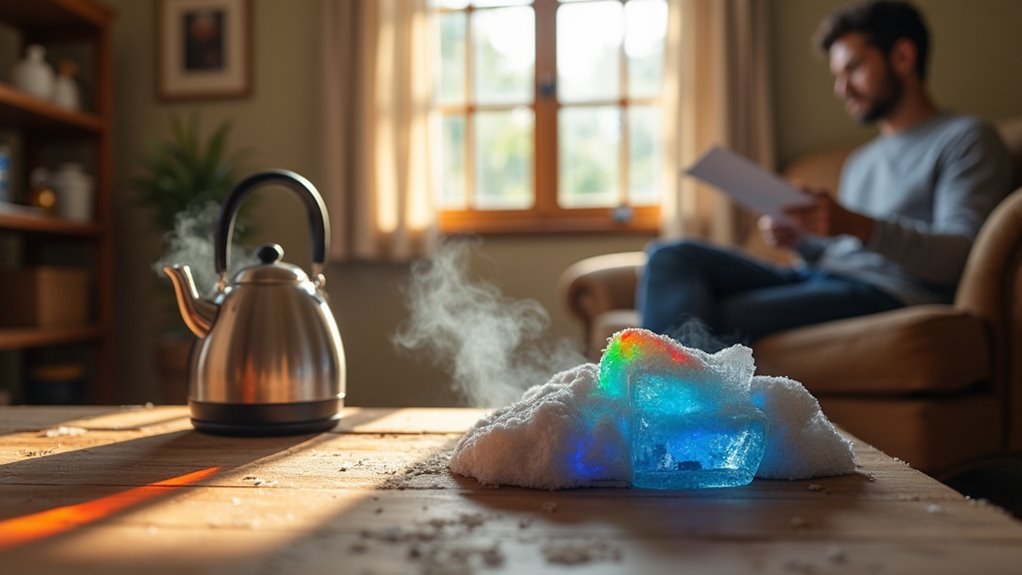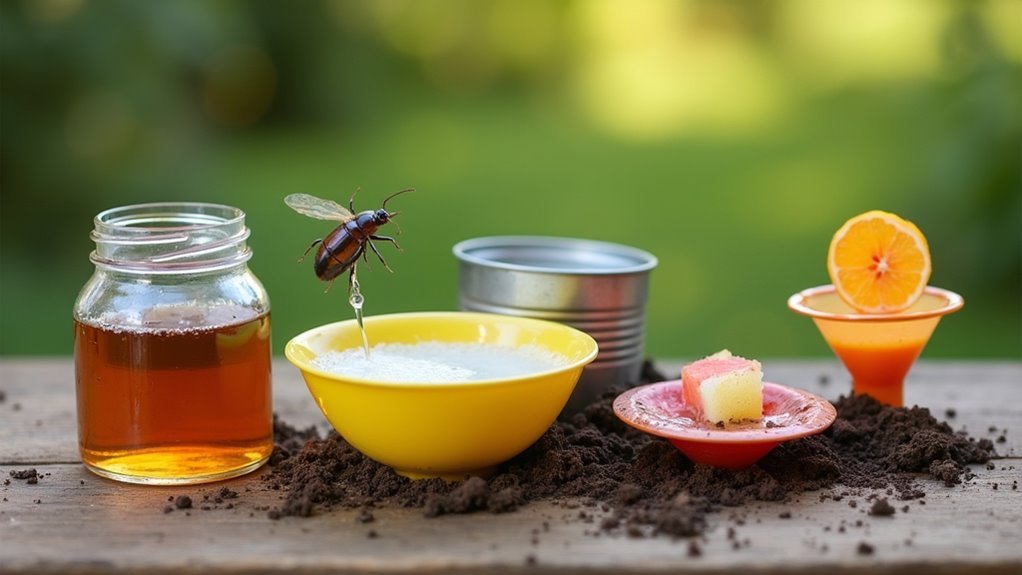You can effectively control household pests using budget-friendly methods that cost under $20. Create vinegar-water solutions to disrupt ant trails, use essential oils like peppermint on cotton balls for deterrent zones, and apply diatomaceous earth for crawling insects. Seal entry points with caulk and weather stripping, maintain strict cleanliness by storing food in airtight containers, and build homemade traps using kitchen ingredients like apple cider vinegar for fruit flies. These proven techniques will help you discover thorough strategies for long-term pest prevention.
Essential Household Items That Repel Common Pests

While commercial pest control products can strain your budget, many items you already have at home can effectively repel unwanted visitors.
A vinegar and water solution creates an effective deterrent for ants and spiders by disrupting their scent trails when sprayed along entry points.
Essential oils like peppermint, tea tree, and eucalyptus mixed with water and dish soap form potent repellent sprays against insects and rodents.
Baking soda combined with sugar attracts cockroaches while eliminating them.
Diatomaceous earth sprinkled in targeted areas dehydrates ants, fleas, and bed bugs on contact.
Citrus oil barriers using lemon juice effectively repel ants and other pests through their strong scent.
Natural Oil-Based Deterrents for Indoor Infestations
You can create powerful pest deterrents using essential oils like peppermint, tea tree, and eucalyptus that’ll repel spiders, rodents, and various insects without harsh chemicals.
Mix these oils with water and dish soap in a spray bottle for direct application, or soak cotton balls and place them strategically around entry points and problem areas.
The key to success lies in understanding proper oil concentrations and maintaining consistent reapplication since these natural deterrents evaporate quickly.
Essential Oil Spray Applications
Three powerful essential oils—peppermint, tea tree, and eucalyptus—offer an effective, natural solution for repelling common indoor pests like spiders and ants without exposing your family or pets to harmful chemicals. These DIY pest control methods work by disrupting insects’ sensory navigation through strong scents.
| Essential Oil | Water Amount | Application Method |
|---|---|---|
| Peppermint essential | 2 cups | Spray entry points |
| Tea tree | 2 cups | Target pest areas |
| Eucalyptus | 2 cups | Soak cotton balls |
Create your spray by mixing 10-15 drops of essential oil with 2 cups water and several drops of dish soap. This natural alternative requires regular reapplication since oils evaporate quickly. Place soaked cotton balls strategically in corners and entryways for continuous protection using these proven pest control methods.
Cotton Ball Placement Strategy
Strategic placement of oil-soaked cotton balls transforms your spray application into a longer-lasting defense system that targets specific pest pathways throughout your home.
This natural barrier approach extends your essential oils’ effectiveness by creating concentrated deterrent zones. Mix 10-15 drops of peppermint, tea tree, or eucalyptus oil with water before soaking your cotton balls for maximum potency.
Focus your placement strategy on these key areas:
- Entry points like doorways, windows, and cracks where pests commonly enter
- Dark corners and baseboards where spiders and insects hide
- Kitchen cabinets and pantry areas that attract ants and rodents
- Behind appliances and furniture where pest activity increases
Replace cotton balls every few days as essential oils evaporate quickly.
This non-toxic pest control method keeps your family and pets safe while effectively deterring unwanted invaders.
Oil Concentration and Effectiveness
Finding the right oil concentration makes the difference between a pest deterrent that works and one that wastes your time and money.
Essential oils require specific concentrations to deliver effective pest control results. You’ll want to mix peppermint, tea tree, and eucalyptus oils at 5-10% concentrations with water and mild dish soap for ideal natural deterrents.
Research shows peppermint oil at just 1% concentration greatly reduces ant activity, while eucalyptus oil works best at 10% for repelling mosquitoes and flies.
Lemon oil creates effective barriers against ants with its citrus scent.
However, oil concentration alone isn’t enough—you must reapply these natural deterrents frequently since essential oils evaporate quickly, losing their effectiveness without consistent application.
Sealing Entry Points to Prevent Pest Access
While pest control products can be expensive, sealing entry points offers one of the most cost-effective ways to protect your home from unwanted invaders. This preventive approach addresses pest problems before they escalate, often eliminating the need for professional pest control services.
Effective sealing strategies include:
- Weather stripping and caulk – Apply around windows, doors, and foundation cracks to block ants and mice
- Regular home inspections – Check for gaps quarterly to identify vulnerabilities early
- Yard maintenance – Trim trees and bushes away from exterior walls to remove pest bridges
- Interior cleanliness – Maintain clutter-free spaces to eliminate hiding spots and improve visibility
Integrated pest management experts consider sealing entry points the foundation of effective pest prevention, making this budget-friendly method essential for long-term protection.
Cleanliness Strategies That Eliminate Pest Attractions

Since prevention forms the cornerstone of budget pest control, maintaining a spotless home environment serves as your most powerful weapon against unwanted invaders.
These cleanliness strategies cost nothing but deliver results that rival expensive pest control service options.
Start by promptly cleaning spills and crumbs, especially in your kitchen where ants congregate around food residues.
Don’t leave dirty dishes in the sink—wash them immediately to eliminate scavenging opportunities.
Prioritize proper food storage using airtight containers that block access from rodents and insects.
Take out garbage frequently and use tightly sealed bins to minimize attractive odors.
Focus on clutter reduction throughout your home, removing hiding spots where pests thrive.
These simple habits often eliminate the need for pest control professionals entirely.
Diatomaceous Earth and Natural Powder Applications
You can apply diatomaceous earth by sprinkling it directly along baseboards, entry points, and areas where you’ve spotted pest activity.
This natural powder works exceptionally well against crawling insects like ants, fleas, and bed bugs by dehydrating them on contact.
The key to maximizing DE’s effectiveness lies in understanding proper coverage techniques and knowing which pests respond best to this treatment method.
Application Methods and Coverage
Three key factors determine diatomaceous earth’s effectiveness: proper application technique, strategic placement, and adequate coverage.
This pest control treatment works best when you apply a thin layer across targeted surfaces without creating thick clumps that insects can easily avoid.
Focus your DE application on these critical areas:
- Entry points – Doorways, windows, cracks, and gaps where pests enter
- Baseboards and corners – Natural pest highways throughout your home
- High-activity zones – Areas where you’ve spotted pest activity
- Moisture-prone spots – Around sinks, bathrooms, and basements
Remember to reapply after cleaning or rainfall, as moisture reduces effectiveness.
You’ll achieve ideal results by combining DE with other methods like sealing cracks and maintaining cleanliness, creating an all-encompassing pest management strategy that targets multiple pest vulnerabilities simultaneously.
Effectiveness Against Specific Pests
Understanding which pests DE targets most effectively helps you maximize your investment and results.
Diatomaceous earth excels against insects with exoskeletons, particularly ants, fleas, and bed bugs. The powder works by absorbing lipids from their protective outer layer, causing fatal dehydration upon contact.
You’ll find it’s especially effective against bed bugs since they can’t avoid crawling through treated areas around mattresses and furniture. Fleas die quickly when DE contacts their bodies, making it superior to many conventional pest control products for carpeted areas.
Ants face continuous exposure as they travel their regular routes through DE barriers. This natural approach proves most effective against crawling insects rather than flying pests, giving you targeted results where traditional methods often fall short.
Heat and Cold Treatment Methods for Specific Pests

When dealing with stubborn pest infestations like bed bugs, heat and cold treatments offer powerful, chemical-free alternatives that won’t compromise your family’s health or safety.
These natural alternative methods target pests at their most vulnerable stages.
Effective heat treatment requires maintaining temperatures of 120°F for at least 90 minutes to eliminate both bugs and eggs completely.
Proper heat treatment effectiveness depends on sustained 120°F temperatures for a minimum 90-minute duration to destroy all life stages.
For budget-conscious homeowners, several options exist:
- Steam treatment – Small steamers cost around $75 and kill bed bugs instantly at 212°F
- Containerized heat devices – ZappBug units range from $200-$350 for non-washable items
- Freezing method – Wrap items in plastic and freeze at 0°F for four days minimum
- Chemical-free pest control – Safe around children and pets when applied correctly
These methods eliminate the need for expensive professional treatments while ensuring thorough eradication.
Homemade Trap Solutions Using Kitchen Ingredients
Your kitchen pantry holds the key to creating effective pest traps without spending money on commercial products.
These homemade trap solutions work surprisingly well against common household invaders.
For fruit flies, fill a jar with apple cider vinegar and add dish soap drops. The soap breaks surface tension, trapping flies effectively.
Combat cockroaches by mixing equal parts baking soda and sugar—the sweet bait attracts them while baking soda proves lethal.
Create powerful ant bait using Borax mixed with honey or syrup. Worker ants carry this deadly mixture back to their colony.
Use vinegar-water spray along entry points to deter spiders.
Capture mosquitoes with a water-filled jar topped with an inverted funnel.
When infestations persist despite these methods, contact a pest control professional.
When DIY Methods Require Professional Backup
While homemade solutions work well for small-scale problems, some pest infestations demand professional expertise to achieve complete elimination. When your DIY methods fail repeatedly, it’s time to contact a pest control company for expert intervention.
Pest Control Tips for recognizing when you need professional help:
- Persistent infestations – If bug problems continue despite multiple DIY attempts, underlying causes may require professional assessment.
- Structural threats – Termites and rodents can cause significant property damage that demands immediate expert attention.
- Severe infestations – Bed bugs and large-scale invasions need specialized equipment and techniques unavailable to homeowners.
- Prevention monitoring – Professional follow-up evaluations prevent re-infestation better than DIY methods alone.
Professional services provide tailored treatment plans and long-term prevention strategies that guarantee thorough pest elimination.
Frequently Asked Questions
What Is the Most Effective Pest Control Method?
You’ll find Integrated Pest Management most effective because it combines prevention, monitoring, and targeted treatment. It’s tailored to specific pests and environments, addressing root causes rather than just symptoms for long-term control.
Do Pest Control Companies Really Work?
Yes, pest control companies really work. You’ll get better results than DIY methods because they use professional-grade products and targeted strategies. They’re especially effective for large infestations you can’t handle yourself.
How Can I Avoid Being Scammed by Pest Control?
You’ll avoid pest control scams by researching companies thoroughly, comparing multiple quotes, verifying licenses and insurance, refusing high-pressure sales tactics, and demanding detailed treatment information before signing contracts.
What Is the Hardest Pest to Get Rid Of?
You’ll find bed bugs are typically the hardest pest to eliminate. They’re incredibly resilient, hide in tiny crevices, resist many pesticides, and can survive months without feeding, making complete eradication extremely challenging.
In Summary
You’ve got plenty of affordable options to tackle pest problems without breaking the bank. Start with what’s already in your pantry, seal up entry points, and maintain a clean environment. Natural oils and diatomaceous earth can handle most common invaders, while temperature treatments work for stubborn cases. Remember, though—if you’re dealing with a serious infestation or dangerous pests, don’t hesitate to call professionals. Sometimes investing in expert help saves money long-term.





Leave a Reply